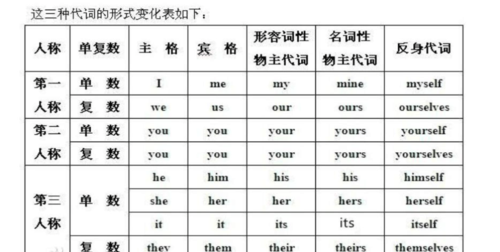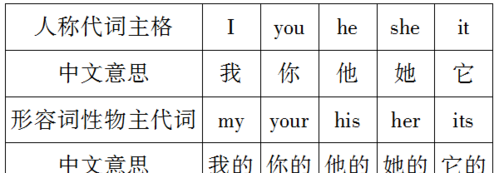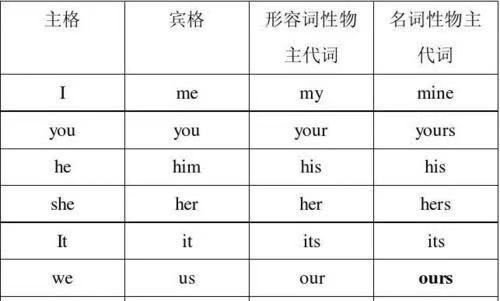本文目录
代词的用法有哪些汉语中
1、 人称代词
人称代词是表示“我”、“你”、“他”、“我们”、“你们”、“他们”等的词,有人称、数和格的变化。
2、人称代词的用法:
1)作主语(用主格)
We all like maths very much. 我们都很喜欢数学。
2)作宾语(用宾格)
Would you mind giving her a hand? 你能帮帮她吗?
I’m very pleased with it. 我对它很满意。
3)作表语(口语常用宾格)
Open the door, please. It’s me. 请打开门,是我
3. 物主代词
物主代词表示所有关系,它可以分为形容词性物主代词和名词性物主代词两种形式。
形容词性
物主代词 my your his, her, its our your their
名词性
物主代词 mine yours his, hers, its ours yours theirs
4. 反身代词
表示“某人自己”的代词,叫反身代词,也叫自身代词。反身代词在句子中可以作宾语、表语和同位语,需要注意反身代词与所指代的名词或代词在人称、性别和数上保持一致。
反身代词的构成是:第一人称和第二人称是“物主代词+-self/selves”,第三人称是“宾格代词+-self/selves”;单数形式是加-self,复数形式是加-selves。

人称代词常以多种形式出现英语
人称代词说白了,就是代替人的名称(人名或人)的词。
主要的作用就是为了让语言更简化。比方,我说:Mike is a basketball player, Mike is well known in the world, Mike is popular both in China and in the US. 太罗嗦了。
人称代词就分2种,主格,和宾格。主格即主人(句子中的主人公),宾格即宾客(句子中除了主人公,出现的其他对象),主格和宾格的区别在于:主格放在句首,宾格通常放在句中,或句尾。

代词有哪三种
代词可分为八类:
1) 人称代词:具有主格(I, you, he, she, it, we, you, they)和宾格(me, you, him, her, it, us, you, them)两种形式。
2) 物主代词:包括形容词性物主代词(my, your, his, her, its, our, your, their)和名词性物主代词(mine, yours, his, hers, its, ours, yours, theirs)两类。
3) 反身代词:myself, yourself, himself, herself, itself, ourselves, yourselves, themselves, oneself.
4) 相互代词:each other, one another.
5) 指示代词:this, that, these, those, it, such, same.
6) 疑问代词:who, whom, whose, which, what.
7) 关系代词:who, whom, whose, which, that, as.
8) 不定代词:some, something, somebody, someone, any, anything, anybody, anyone, no, nothing, nobody, no one, every, everything, everybody, everyone, each, much, many, little, a little, few, a few, other, another, all, none, one, both, either, neither.

人称代词的各种形式
百度首页 | 登录
新闻 网页 贴吧 知道 MP3 图片 百科 帮助
百度百科 > 浏览词条
编辑词条 发表评论 历史版本 打印 添加到搜藏
代词
代词的定义
代词用来代替名词或名词词组,在句中用以避免名词的重复。
因此,代词的使用必须和它所代替的名词在人称、数、性、格上取得一致。
代词的分类 人称代词 物主代词 反身代词 相互代词 指示代词 疑问代词 关系代词 不定代词
一.人称代词:人称代词是指人或事物的代词。有人称、数、格的变化。
第三人称单数的人称代词还有性的变化。
1.人称代词列表
第一人称单数
I me 我
第二人称单数
you you 你
第三人称单数
he him 他(阳性)
she her 她(阴性)
it it 它
第一人称复数
we us 我们
第二人称复数
you you 你们
第三人称复数
they them 他们、她们、它们
2.人称代词的句法功能
作主语(用主格形式)
We are cooks.
我们是厨师。
作表语(用主格形式)
It's I.
是我。
注意:在正式场合中,当表语的代词应采用主格形式。
但是在口语习惯上人们常用宾格形式。如:It's me.
作宾语(用宾格形式)
This is my hat. Do you like it?
这是我的帽子。你喜欢吗?
作介宾(用宾格形式)
My brother often takes care of me.
我哥哥经常照顾我。
3.人称代词的其他用法
指可爱、美丽的动物用 she 表示,指凶猛的动物用 he 表示
I've a lovely cat. She is my favorite.
我有一只可爱的猫。她是我的宠物。
The dog waved his tail when he saw his master.
那只狗看到主人就摇尾巴。
表示车、船、祖国、大地、月亮等时常用 she 表示
China is my motherland. She's getting more and more beautiful.
中国是我的祖国。她正变的越来越美丽。
What's wrong with the car? She won't start.
车怎么啦?她发动不起来。
用 we、you、they 泛指一般人。
We all make mistakes.
每个人都会犯错误。
You should keep calm even when you are in danger.
即使在危急时刻也要保持冷静。
They say it's going to be another cold winter.
据说一个寒冷的冬天即将来临。
4.人称代词的排序
几个人称代词同时作主语时,排列顺序通常为:
you and I
you and he (she)
he (she) and I
you, he (she) and I
we and you
we and they
we, you and they
例如:
You, he and I should help each other.
我、你、他应该互相帮助。
She and I are of the same age.
我和她同岁。
在承认错误时,“I”放在其他人称前面表示勇于承认错误。
例如:
I and my brother made the mistake.
我和弟弟犯了这个错误。
二.物主代词
表示所有关系的代词叫做物主代词。物主代词分为形容词性物主代词和名词性物主代词两种。物主代词有人称和数的变化。第三人称单数的物主代词还有性的变化。
物主代词列表
第一人称单数
my mine 我的
第二人称单数
your yours 你的
第三人称单数
his his 他的(阳性)
her hers 她的(阴性)
its its 它的
第一人称复数
our ours 我们的
第二人称复数
your yours 你们的
第三人称复数
their theirs 他们的、她们的、它们的
1.物主代词的句法功能
形容词性物主代词只能当定语。
名词性物主代词可以当主语、表语、宾语。
形容词性物主代词当定语
My school is not far from here.
我的学校离这儿不远。
名词性物主代词当主语
Ours is the best football team in the school.
我们的足球队是全校最棒的。
名词性物主代词当表语
The book on the desk isn't mine.
桌子上的那本书不是我的。
名词性物主代词当宾语
I forgot to bring my pen. May I use yours?
我忘了带钢笔。我可以借用以下你的吗?
2.物主代词的其他用法
形容词性物主代词的其他用法
英语中表示身体所有的、随手携带的常用形容词性物主代词,汉语中却
没有这样的使用习惯。
He put on his hat and left.
他戴上帽子就走了。
形容词性物主代词与 own 连用表示强调。
I won't believe it until I see it with my own eyes.
直到我亲眼看到我才会相信。
以下结构中,必须用 the ,而不能用形容词性物主代词。
touch sb. on the head 摸某人的头
hit sb. in the face 打某人的脸
hit sb. on the nose 打某人的鼻子
strike sb. in the chest 打某人的胸部
catch sb. by the arm 抓住某人的手臂
名词性物主代词和 of 连用当定语,构成双重所有格。
That son of hers is very lovable. 她的那个儿子很可爱。
This painting of his is very excellent. 他的这副画非常优秀。
三.反身代词
反身代词表示动作回到其执行者本身用以加强语气。
反身代词列表
第一人称单数
myself 我自己
第二人称单数
yourself 你自己
第三人称单数
himself 他自己
herself 她自己
itself 它自己
第一人称复数
ourselves 我们自己
第二人称复数
yourselves 你们自己
第三人称复数
themselves 他们自己、她们自己、它们自己
反身代词的句法功能
1.作表语
She's not herself today.
她今天跟平常真是判若两人。
2.作宾语
Please help yourself to some fish.
请随便吃点鱼。
3.作介宾
I learned English by myself.
我自学英语。
4.作同位语
He can do that himself.
他自己能做那件事。
反身代词用来强调名词或代词
The king himself gave her the medal.
是国王亲自授予她勋章的。
在口语中 self 要重读。
这样使用的这类代词本身决不是必不可少的,如被省略也不会改变句子的意思。 这类代词通常用来强调句子的主语,这时应位于主语之后:
Ann herself opened the door.
安亲自开门.
Tom himself went.
汤姆亲自去了。
在有宾语时也可位于宾语之后:
Ann opened the door herself.
安亲自开门。
也可位于不及物动词之后:
Tom went himself.
汤姆亲自去了。
身代词的习惯用法
in oneself 本身、本质上
to oneself 供自己用
by oneself 独自地、单独地
for oneself 替自己
amuse oneself 自娱自乐
help oneself to 随便吃
enjoy oneself 过得很快活
teach oneself 自学
speak to oneself 自言自语
devote oneself to 献身于...
lose Oneself= lose one's way 迷路
make oneself understand 让别人懂得自己的意思
among one selves 在...之间
between one selves 私下说的话<不可告诉别人>
四.相互代词
用来表示相互关系的代词叫做相互代词。
英语中相互代词只有两个each other和one another 。
在当代英语中each other和one another没有什么区别。
相互代词的用法
1. 作宾语
We often help each other in our lessons.
我们经常在功课上互相帮助。
They see one another every day.
他们每天见面
2. 作介宾
Let's learn from each other.
咱们互相学习吧.
3. 作定语时须用所有格
They know each other's parents.
五.指示代词
英语中把用来表示"这个、那个、这些、那些"等指示概念的代词
称为指示代词。
常见的指示代词有:
this 这个 that 那个
these 这些 those 那些
such 如此的 same 相同的
六.疑问代词
疑问代词是指用来构成特殊疑问句的代词。
疑问代词有:what which who whom whose 。
疑问代词通常位于句首,并在句子中担任一定的句子成分。以疑问
代词引导的间接疑问句可在复合句中当主语从句、宾语从句、表语
从句。疑问代词本身在从句中又担任一定的句子成分。
疑问代词列表
who 指人,担任主语,在口语中也可担任宾语。
whom 指人,担任宾语、介宾。
whose 相当于所有格,可当主语、宾语、表语、定语。
what 指物,可当主语、宾语、表语、定语。
which 表示在一定范围内的"哪一个",可当主语、宾语、定语。
七.不定带词
不是指明代替任何特定名词(或形容词)的代词叫做不定代词。
不定代词列表
some 一些(可数或不可数)
somebody 某人
someone 某人
something 某事,某物
any 一些,任何(可数或不可数)
anybody 任何人
anyone 任何人
anything 任何事,任何物
no 无(可数或不可数)
nobody 无人
no one 无一人
nothing 无事 无物
all 全体,全部
both 两个
none 没有人或物(指两个以上当中)
each 每个
neither 没有人或物(指两个当中)
either 任何一个(指两个当中)
every 每个
everyone 每人
everybody 每人,大家,人人
everything 每一个事物,一切
other 另一个
others 另一些
another 另外一个,又一个
many 很多(可数)
much 很多(不可数)
few 很少(可数)
a few 一些,几个(可数)
little 很少(不可数)
a little 一些(不可数)
one 一个(人或物)
八.关系代词
具有连接作用的关系代词
that which
who whom
whose
关于“关系代词”的用法见名词性从句。
关系代词有:who, whom, whose, that, which, as。
关系代词作宾语的省略:
The man (who, whom) I wanted to see was away.
我想见的那个人不在。
Have you found the key ( that) you lost yesterday?
你昨天丢失的那把钥匙找到了没有?
The dress (that) Ann bought doesn’t fit her very well.
安买的那件衣服不太合身。
2. the way之后的省略:
I don’t like the way ( in which) you laugh at him.
我不喜欢你嘲笑他的那个方式。
They can’t help seeing things in the way ( that) they do.
他们忍不住用那种方式看事物。
3. reason之后的省略:
He refused to disclose the reason (why) he did it.
他拒绝披露他作那件事的缘由。
编辑词条
开放分类:
词类、英语

以上就是关于代词出现形式 ,代词的用法有哪些汉语中的全部内容,以及代词出现形式 的相关内容,希望能够帮到您。

